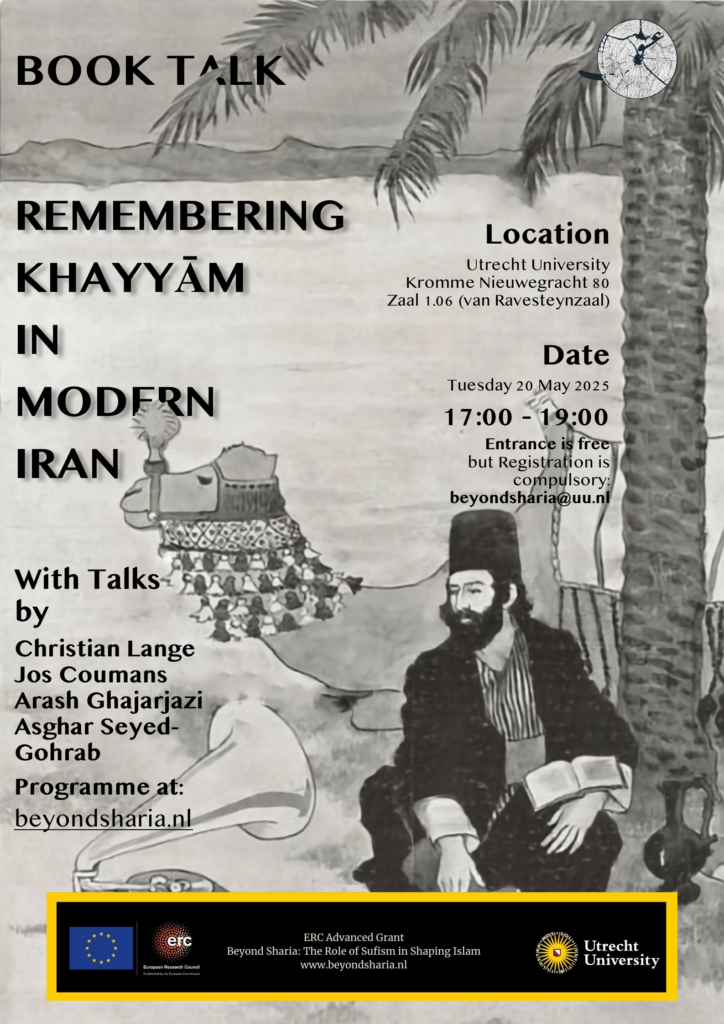You are warmly invited to a book talk on the occasion of the recent publication of Remembering ʿUmar Khayyām: Episodes of Unbelief in the Reception Histories of Persian Quatrains by Arash Ghajarjazi.
With contributions from:
• Christian Lange (Utrecht University)
• Jos Coumans (Nederlands Omar Khayyam Genootschap)
• Arash Ghajarjazi (Utrecht University)
• Asghar Seyed-Gohrab (Utrecht University)
Date: Tuesday, 20 May 2025
Location: Utrecht University, Kromme Nieuwegracht 80, Room 1.06 (van Ravesteynzaal)
Time: 17:00–19:00
Registration: Attendance is free, but registration is required: beyondsharia@uu.nl

Programme:
Khayyam as eschatologist – Christian Lange
Abstract and biography will be announced soon.
The Rubáiyát parody: a short lived phenomenon – Jos Coumans
Edward FitzGerald’s translation of the Rubáiyát of Omar Khayyám has been a very well known poem and since its first edition in 1859 it has never been out of print. Kháyyam’s rise to fame, expressed in numbers of editions, peaked between 1910 and 1930, and it radiated on various aspects of arts and culture such as music, drama and commerce ever since.
One aspect that I will shed a little light on is that of the rubáiyát-parody. It has been studied before by Jos Biegstraaten (2005), Annmarie Drury (2011), Michelle Kaiserlian (2009 and 2011), Parvin Loloi (2011) to mention only a few. A recent search in a number of digital newspapers archives however retrieved such an enormous amount of unknown and undocumented parodies that a further action was required. In my presentation I will take you on a little journey into a fascinating phenomenon that surprisingly or not,disappeared almost as quickly as it emerged.
Jos Coumans is independent scholar and secretary of the Nederlands Omar Khayyám Genootschap (The Dutch Omar KhayyámSociety). He has published a monograph on Omar Khayyam, entitled The Rubáiyát of Omar Khayyám: An updated bibliography (Leiden: Leiden University Press, 2010) and many articles, among which “Bois du vin … English, French and German translations in Persian polyglot editions of The Rubáiyát of Omar Khayyám,” in Persica, No. XXVI (2017-2018), pp. 103-163; The erring finger writes. The Leicester pirate cyclostyles of the Rubáiyát of Omar Khayyám, Jos Coumans, John Drew. Cambridge: Cambridge Poetry Workshop, 2015; A book in the wilderness. FitzGerald’s Rubáiyát of Omar Khayyám 150 years in print and image, Jos Biegstraaten en Jos Coumans. Amsterdam: Rozenberg, 2009; “Inleiding en verantwoording bij de bibliografie. – Bibliografie,” in Boekenwereld, jrg. 13 (1997), nr. 3 (mrt.), pp. 130-144. He is also webmaster of the following sites related to Khayyam:
- Omar Khayyam in Nederland – https://omarkhayyam.nl
- Omariana – https://omariana.nl
- Concordances of the Rubáiyát – https://rubaiyatconcordance.org
- Omar Khayyám – https://omarkhayyamnederland.com
Remembering Khayyām in Modern Iran – Arash Ghajarjazi
This talk is based on the book Remembering Khayyām: Episodes of Unbelief in the Reception Histories of Persian Quatrains. It opens with the argument that Khayyām was not a literary figure continuously transmitted from medieval Persian literature to modern Iran. Rather, the figure was rediscovered and reconstructed in the modern era through a complex relationship between Iranian nationalism, mass media, and shifting public perceptions of Islam. This modern re-canonisation occurred more than half a century after Edward FitzGerald’s world-famous Rubáiyát was published, when the Iranian scholar Muḥammad Qazvīnī introduced it to the Persian press in 1909, via the British Orientalist Edward Browne. Within a decade of this introduction, Khayyām began to be hailed as part of Iran’s national literary heritage, frequently mentioned in the Persian press and literary circles, both within Iran and across its diaspora. His name was increasingly listed alongside Ferdawsī, Ḥāfiẓ, and Rūmī – figures who had long been canonised as Persian literary classics – given the fact that Khayyām’s poetry had remained largely marginal in Safavid and Qajar anthologies and was nearly absent from 19th-century publications.
The re-emergence of Khayyām in the early twentieth century, then, was not a “natural” act of literary remembrance. It was instead embedded in broader transformations within the Iranian state and society, which were reconfiguring their literary and religious imaginaries in dialogue with European Orientalist discourses. The talk argues that it was no coincidence that Khayyām’s collective remembrance in twentieth-century Iran became closely linked to debates over religion, secularism, and unbelief. Drawing on underexamined sources, including Persian and British periodical literature, Qazvīnī’s Persian commentaries, and Ṣādiq Hidāyat’s modernist appropriations, I trace the styles through which Khayyām was remembered and made into a symbol of national heritage in modern Iran. Finally, I consider how this legacy of Pahlavi-era heritage-making persists in the present. As a telling example, during the 2025 Nowruz celebrations, many Iranians gathered at the tombs of classical poets such as Ferdawsī, Ḥāfiẓ, and, most controversially, Khayyām. There, they chanted pro-Shah slogans, openly defied the state’s ḥijab mandate, and in some cases expressed Aryanist, anti-Arab sentiments.
Arash Ghajarjazi
I am a postdoctoral researcher at Utrecht University’s Department of Philosophy and Religious Studies, working in Beyond Sharia: The Role of Sufism in Shaping Islam. My scholarship integrates Iranian Studies, media history, memory studies, and digital humanities, with a focus on modern and contemporary Iran. My research is grounded in extensive archival work across Iran, Europe, and the United States. With an interdisciplinary academic background, including degrees in Islamic and Religious Studies (PhD), Media and Performance Studies (MA), English Language and Culture (BA), and Mathematics (MSc), I bring a multifaceted perspective to the study of religion, media, and modernity. I have authored two monographs: Irrationalities in Islam and Media in Nineteenth-Century Iran (2022), which offers a media-archaeological approach to Iran’s religious modernity, and Remembering Umar Khayyam: Episodes of Unbelief in the Reception Histories of Persian Quatrains (2025), which explores the intersections of religion, memory, and literature in Iran’s secular intellectual history. I have taught courses on the Modern Middle East and on Media and Religion.
Reflections on Khayyam’s Modern Reception – Asghar Seyed-Gohrab
In this paper, I will discuss the rich reception of Khayyam in Iran by scholars, politicians, and religious figures. Each group has appreciated the quatrains attributed to Khayyam differently, inviting audiences to view him in new and conflicting dimensions, ranging from a non-conformist and antinomian figure to a secular or agnostic Persian sage, to a devout mystic believer. My analysis revolves around questions such as: why does Sadeq Hedayat’s Khayyam do not do justice to the historical figure? Why is Khayyam often considered as a vanguard of antinomianism, and why is his legacy at times deployed in the field of literary diplomacy?
Asghar Seyed-Gohrab is Professor of Iranian and Persian Studies at Utrecht University in the Department of Philosophy and Religious Studies. He has published extensively on Persian literature, mysticism and religion. His publications range from Persian poetry to Sufism and the role of non-conformist movements in Persianate cultural areas. He authored Soefisme: een levende traditie, (Amsterdam: Prometheus/Bert Bakker, 2015 third print); The True Dream: Indictment of the Shiite Clerics of Isfahan, (London: Routledge, 2017, with S. McGlinn), Layli and Majnun: Love, Madness and Mystic Longing in Nizami’s Epic Romance, (Leiden / Boston: Brill, 2003), Mirror of Dew: The Poetry of Ālam-Tāj Zhāle Qā’em-Maqāmi, (Cambridge: Harvard University Press, Ilex Foundation Series 14, 2015), Courtly Riddles: Enigmatic Embellishments in Early Persian Poetry, (Leiden: LUP, 2008, 2010). His recent publication is Martyrdom, Mysticism and Dissent: The Poetry of the 1979 Iranian Revolution and the Iran-Iraq War (1980-1988) (Berlin: De Gruyter, 2021). His most recent book is Of Piety and Heresy: Abū Ḥāmid Muḥammad Ghazzālī’s Persian Treatises on Antinomians, Berlin: De Gruyter, 2024. At the moment he is the Principal Investigator (PI) of an ERC-Advanced Grant entitled Beyond Sharia: The Role of Sufism in Shaping Islam (www.beyondsharia.nl), examining Islamic non-conformist movements.

